The Seagate BarraCuda (500GB) SSD Review: Getting Back In The Game
by Billy Tallis on December 7, 2018 8:00 AM ESTAnandTech Storage Bench - Heavy
Our Heavy storage benchmark is proportionally more write-heavy than The Destroyer, but much shorter overall. The total writes in the Heavy test aren't enough to fill the drive, so performance never drops down to steady state. This test is far more representative of a power user's day to day usage, and is heavily influenced by the drive's peak performance. The Heavy workload test details can be found here. This test is run twice, once on a freshly erased drive and once after filling the drive with sequential writes.

The Seagate BarraCuda's average data rate on the Heavy test is lower than normal for mainstream TLC SATA drives. The Plextor M8V performs similarly, suggesting that the Toshiba 3D TLC NAND is a more important contributor to this poor performance than the aging Phison S10 controller that the BarraCuda uses. Overall performance from the BarraCuda doesn't suffer much when the test is run on a full drive, but that's also generally true of current-generation mainstream drives.
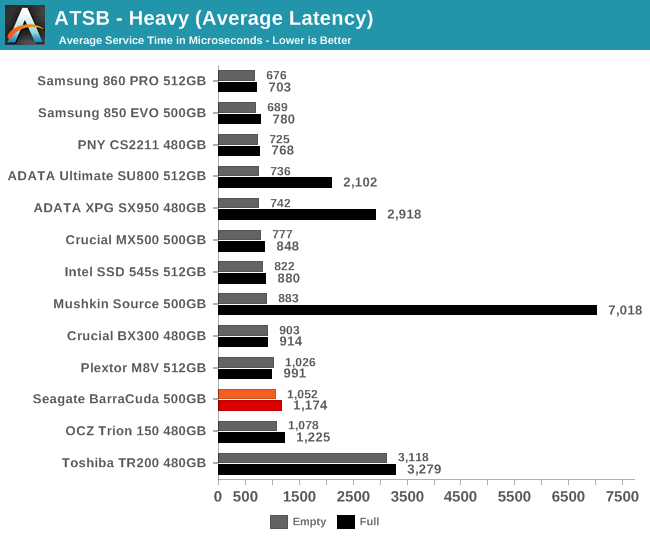
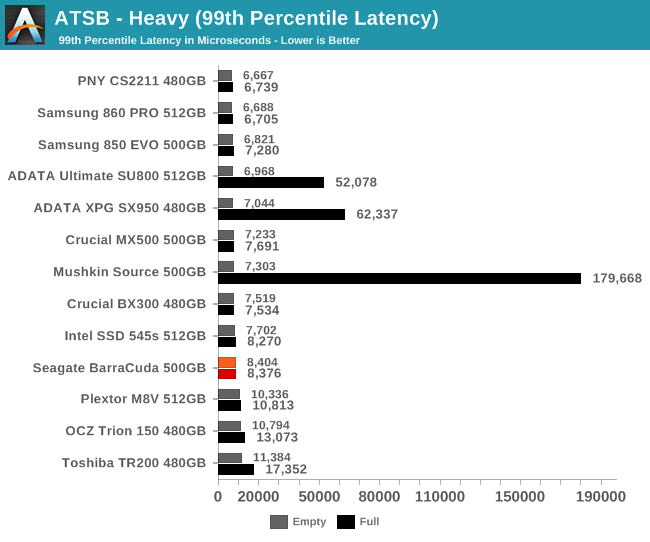
The average and 99th percentile latency scores from the BarraCuda are a bit on the high side, but the gap between the BarraCuda and the fastest SATA drives is less than a factor of two. More importantly, the BarraCuda is not a severe outlier even for the full-drive test run, and it does not appear that the BarraCuda suffers from any severe stuttering even under intense workloads.

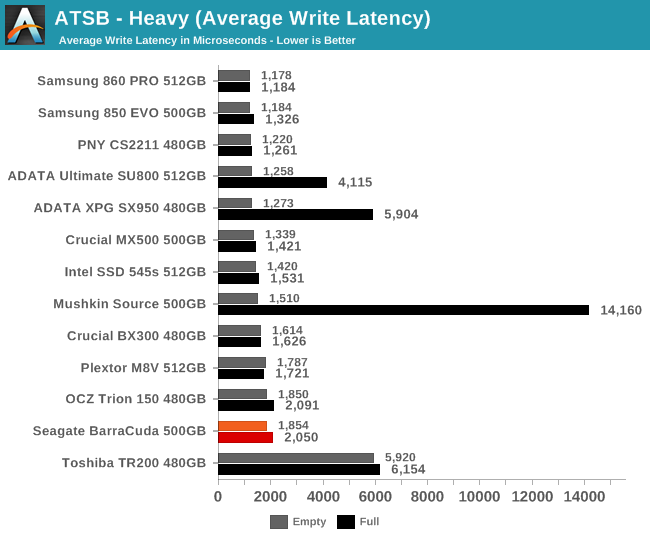
The average read and write latencies for the BarraCuda aren't vastly slower than other mainstream drives, but the BarraCuda does rank near last place among its primary competitors, with write latency being a bit more of a problem than read latency.

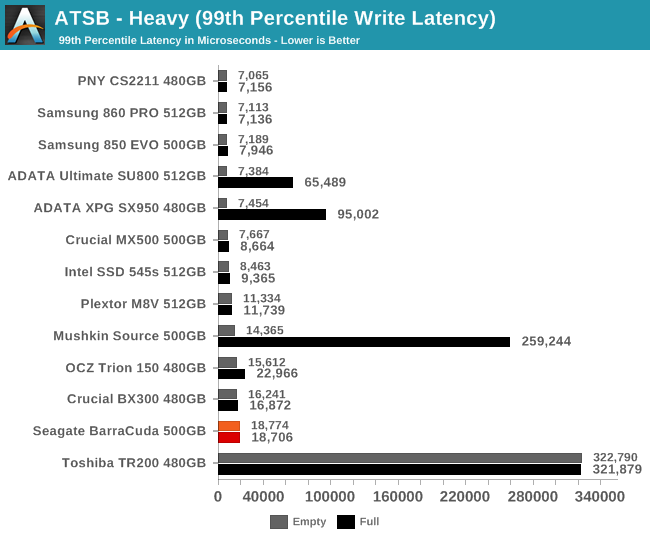
The 99th percentile read latency from the BarraCuda is only slightly worse than other mainstream TLC drives, and fortunately much better than the Plextor M8V's score. The BarraCuda's 99th percentile write latency is worse off, with more than twice the latency of its primary competition.
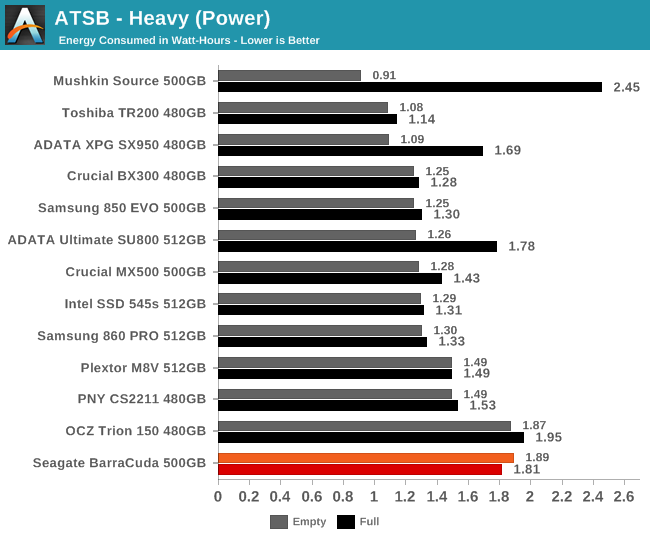
The Seagate BarraCuda is more or less tied with the planar TLC-based OCZ Trion 150 for worse overall energy efficiency on the Heavy test, though the DRAMless Mushkin Source is so slow on the full-drive test run that its energy usage outstrips everything else.










39 Comments
View All Comments
Hulk - Friday, December 7, 2018 - link
Fantastic review as always. Thanks for your hard work.But I'm curious as to why the Samsung EVO 860 isn't in the benchmarks. It was recently selling for under $130 (not back at $150) and seems to be the benchmark to which most drives in this category should be compared?
Gasaraki88 - Friday, December 7, 2018 - link
The 850 EVO and 860 EVO are very similar in performance.Samus - Friday, December 7, 2018 - link
The problem for Samsung's consumer market is they've been making drives that max out the capabilities of SATA for 5 years. There just isn't much more room to improve.And the problem for Samsung's prosumer market is the WD Black NVMe is an overall better value than the 970 NVMe, ESPECIALLY in mobile where the 970's (even the EVO) are so power hungry they constantly throttle in laptops, while reducing battery life.
Samsung is riding on reputation right now. Superior products in the SATA space are irrelevant because at the high end you wont notice a real difference between SATA drives. And in the NVMe space, there are plenty of players on par with Samsung.
zodiacfml - Monday, December 10, 2018 - link
I used to think that SATA is dumb for recent SSDs. However, I noticed that it is only for sequential workloads which can be left running in the background. SATA still has a lot of life for SSDs.The 2.5" form factor is still dumb though. It is huge waste of space and materials.
Can't they make the case the size of the PCB using only the first pair of screws for mounting?
derekullo - Monday, December 10, 2018 - link
The reason this was done was to safe on space knowing that eventually they would deployed in laptops.Another reason was that when ssds were first being released with SLC, they were incredibly expensive and nobody could afford to buy your 1 Terabyte 3.5" drive filled to the brim with SLC nand. Of course we can afford it now ...
derekullo - Monday, December 10, 2018 - link
save on space* be deployed*Billy Tallis - Friday, December 7, 2018 - link
My smallest 860 EVO sample is 1TB, and I didn't want to put that on the graphs as the only drive of that capacity. Performance generally increases with drive capacity, so the 1TB would exaggerate the performance advantage of the 860 EVO over the BarraCuda (and probably slightly understate the efficiency advantage). You can make the comparison with our Bench tool if you're interested: https://www.anandtech.com/bench/product/2201?vs=21...Hulk - Friday, December 7, 2018 - link
Okay that makes sense.Death666Angel - Friday, December 7, 2018 - link
2.5" SATA SSDs should just become M.2 SATA SSDs with a caddy. :)Dragonstongue - Friday, December 7, 2018 - link
not everyone has m.2 on their boards and many of those boards overheat the drive in that slot anyways....t each own, "slow" drives are best kept as full out SATA sized drive (which vast majority are 2.5" anyways. the samsung 8/9xx are "unique" in that the pcb housing the memory chips etc is quite small compared to many so they "easily" put on a m.2 "gum stick"